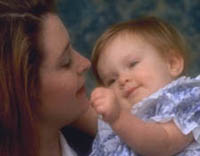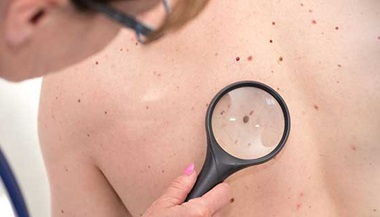Birthmarks
What are birthmarks?
Birthmarks are areas of discolored and/or raised skin that are apparent at birth or within a few weeks of birth. Birthmarks are made up of malformed pigment cells or blood vessels.
Although the cause of birthmarks is not known, most of them are benign (noncancerous) and do not require treatment. Babies with birthmarks should be examined and diagnosed by a health care provider.
What are the most common types of vascular birthmarks?
The following are the most common types of vascular birthmarks:
-
Macular stains or salmon patches. These are characterized by pink to red marks that may appear anywhere on the body. Angel kisses and stork bites are the most common type of vascular birthmark:
-
Angel's kisses. Marks located on the forehead, nose, upper lip, and eyelids that usually disappear with age.
-
Stork bites. Marks on the back of the neck that usually disappear with age.
-
-
Hemangioma. A common vascular birthmark. Hemangiomas become visible within the first few weeks or months of life and continue to grow rapidly for about 6 to 9 months. Then, they gradually lose this red color and also shrink. They are called strawberry patch hemangiomas. By age 5, 50% resolve and 90% resolve by age 9 without any treatment. Hemangiomas that grow into other organs or structures or become ulcerated should be evaluated by your health care provider.
-
Port-wine stain (also called nevus flammeus). A port-wine stain is a flat, pink, red, or purple mark that appears at birth, often on the face, arms, and legs, and continues to grow as the child grows. Port-wine stains do not go away and often need treatment if located on the eyelid or forehead. Port-wine stains involving the face may cause eye problems and be associated with other developmental disorders.
What are the most common types of pigmented birthmarks?
The following are the most common types of pigmented birthmarks:
-
Moles (also known as congenital nevi). These can be skin-colored, brown, or black, flat or raised and small or large. They can happen anywhere on the body. Moles can also happen in adulthood, but only moles that are present at birth are considered birthmarks. Other nevi that behave like congenital nevi can appear within the first 2 years of life. Congenital nevi can develop into cancer later in life, with larger nevi having a higher risk of becoming cancerous.
-
Cafe-au-lait spots. This is French for coffee with milk. These are usually oval-shaped and light brown or black. Typically these fade with age and are not a problem. However, many of them grouped together can be a sign of other health issues and should be examined by a health care provider.
-
Mongolian spots. These are blue or blue-gray spots on the lower back or buttocks. They are most common in babies with darker skin, like African-American or Asian babies. They can be mistaken for bruises and they usually fade with age.






